Experimental Study on Flexural Performance of Recycled Steel Fiber Concrete Beams
Abstract
:1. Introduction
2. Test Overview
2.1. Test Material and Mix Ratio
2.2. Preparation of Test Beams
2.3. Test Loading and Measurement
2.3.1. Loading Device and Measurement Point Arrangement
2.3.2. Loading System
3. Experimental Phenomena and Analysis
3.1. Test Phenomenon
3.1.1. NCB
3.1.2. RSFCB—0.5%
3.1.3. RSFCB—1%
3.1.4. RSFCB—1.5%
3.1.5. RSFCB—2.0%
3.2. Analysis of Test Results
3.2.1. Cracking Load and Ultimate Load
3.2.2. Plane Section Assumption
3.2.3. Load–Strain Analysis of Tensioned Longitudinal Reinforcement
3.2.4. Load–Deflection Curve
4. Conclusions
- (1)
- The NCB beam showed compressive failure, while the failure mode of the WSFRCBs were approximately the same with equilibrium failure. The RSFCB test beams all met the plane section assumption, and the steel bars reached yield during loading. When the yield point was reached, the yield strain of the steel bars was relatively close.
- (2)
- The cracking load and ultimate load of the WSFRCBs are higher than those of the NCB. The ultimate load generally shows a trend of increasing first and then decreasing with the increase in steel fiber content. When the steel fiber content is 1.5%, the ultimate load is the largest, which is 49.09% higher than that of the NCB. RSF can inhibit the development of cracks. The number of cracks increases with the increase in steel fibers, but the width decreases, achieving the effect of toughening, thereby effectively improving the ductility of the beam.
- (3)
- Reclaimed steel fibers can work together with concrete to improve the bearing capacity of reinforced concrete beams while limiting the development of longitudinal strains, allowing the longitudinal steel bars to yield under higher loads and improving the deformation capacity of reinforced concrete beams. The results also show that recycled steel fiber concrete has similar mechanical properties to ordinary steel fiber concrete, making it feasible for engineering practice.
Author Contributions
Funding
Data Availability Statement
Acknowledgments
Conflicts of Interest
References
- Wu, P.; Song, Y.; Zhu, J.; Chang, R.D. Analyzing the influence factors of the carbon emissions from China’s building and construction industry from 2000 to 2015. J. Clean. Prod. 2019, 221, 552–566. [Google Scholar] [CrossRef]
- Li, S.; Wu, Q.; Zheng, Y.; Sun, Q. Study on the Spatial Association and Influencing Factors of Carbon Emissions from the Chinese Construction Industry. Sustainability 2021, 13, 1728. [Google Scholar] [CrossRef]
- Toghroli, A.; Mehrabi, P.; Shariati, M.; Trung, N.T.; Jahandari, S.; Rasekh, H. Evaluating the use of recycled concrete aggregate and pozzolanic additives in fiber-reinforced pervious concrete with industrial and recycled fibers. Constr. Build. Mater. 2020, 252, 118997. [Google Scholar] [CrossRef]
- Gao, D.; Zhang, L.; Zhao, J.; You, P. Durability of steel fibre-reinforced recycled coarse aggregate concrete. Constr. Build. Mater. 2020, 232, 117119. [Google Scholar] [CrossRef]
- Zhong, H.; Chen, M.; Zhang, M. Effect of hybrid industrial and recycled steel fibres on static and dynamic mechanical properties of ultra-high performance concrete. Constr. Build. Mater. 2023, 370, 130691. [Google Scholar] [CrossRef]
- Zia, A.; Zhang, P.; Holly, I. Experimental investigation of raw steel fibers derived from waste tires for sustainable concrete. Constr. Build. Mater. 2023, 368, 130410. [Google Scholar] [CrossRef]
- Mastali, M.; Dalvand, A. Fresh and Hardened Properties of Self-Compacting Concrete Reinforced with Hybrid Recycled Steel–Polypropylene Fiber. J. Mater. Civ. Eng. 2017, 29, 04017012. [Google Scholar] [CrossRef]
- El-Sayed, T.A.; Shaheen, Y.B. Flexural performance of recycled wheat straw ash-based geopolymer RC beams and containing recycled steel fiber. Structures 2020, 28, 1713–1728. [Google Scholar] [CrossRef]
- Leone, M.; Centonze, G.; Colonna, D.; Micelli, F.; Aiello, M.A. Fiber-reinforced concrete with low content of recycled steel fiber: Shear behaviour. Constr. Build. Mater. 2018, 161, 141–155. [Google Scholar] [CrossRef]
- Peng, G.F.; Niu, X.J.; Long, Q.Q. Experimental Study of Strengthening and Toughening for Recycled Steel Fiber Reinforced Ultra-High Performance Concrete. Key Eng. Mater. 2014, 629, 104–111. [Google Scholar] [CrossRef]
- Mastali, M.; Dalvand, A.; Sattarifard, A.R.; Abdollahnejad, Z.; Illikainen, M. Characterization and optimization of hardened properties of self-consolidating concrete incorporating recycled steel, industrial steel, polypropylene and hybrid fibers. Compos. Part B Eng. 2018, 151, 186–200. [Google Scholar] [CrossRef]
- Siddika, A.; Al Mamun, M.A.; Alyousef, R.; Amran, Y.H.M. Strengthening of reinforced concrete beams by using fiber-reinforced polymer composites: A review. J. Build. Eng. 2019, 25, 100798. [Google Scholar] [CrossRef]
- Yang, J.; Peng, G.F.; Shui, G.S. Mechanical Properties and Anti-Spalling Behavior of Ultra-High Performance Concrete with Recycled and Industrial Steel Fibers. Materials 2019, 12, 783. [Google Scholar] [CrossRef] [PubMed]
- Neocleous, K.; Tlemat, H.; Pilakoutas, K. Design Issues for Concrete Reinforced with Steel Fibers, Including Fibers Recovered from Used Tires. J. Mater. Civ. Eng. 2006, 18, 677–685. [Google Scholar] [CrossRef]
- Teng, J.G.; Yu, T.; Fernando, D. Strengthening of steel structures with fiber-reinforced polymer composites. J. Constr. Steel Res. 2012, 78, 131–143. [Google Scholar] [CrossRef]
- Frazão, C.; Díaz, B.; Barros, J. An experimental study on the corrosion susceptibility of Recycled Steel Fiber Reinforced Concrete. Cem. Concr. Compos. 2018, 96, 138–153. [Google Scholar] [CrossRef]
- Frazão, C.M.V.; Barros, J.A.B.; Bogas, J.A. Durability of Recycled Steel Fiber Reinforced Concrete in Chloride Environment. Fibers 2019, 7, 111. [Google Scholar] [CrossRef]
- Liew, K.M.; Akbar, A. The recent progress of recycled steel fiber reinforced concrete. Constr. Build. Mater. 2020, 232, 117232. [Google Scholar] [CrossRef]
- Mansour, W.; Fayed, S. Flexural rigidity and ductility of RC beams reinforced with steel and recycled plastic fibers. Steel Compos. Struct. 2021, 41, 317–334. [Google Scholar] [CrossRef]
- Bichitra, S.N.; Kranti, J. Shear resistant mechanisms in steel fiber reinforced concrete beams: An analytical investigation. Structures 2022, 39, 607–619. [Google Scholar] [CrossRef]
- Cristina, F.; Joaquim, B.; Alexandre, B.J. Technical and environmental potentialities of recycled steel fiber reinforced concrete for structural applications. J. Build. Eng. 2022, 45, 103579. [Google Scholar] [CrossRef]
- Gao, D.Y.; Zhu, W.W.; Fang, D.; Tang, J.Y.; Zhu, H.T. Shear behavior analysis and capacity prediction for the steel fiber reinforced concrete beam with recycled fine aggregate and recycled coarse aggregate. Structures 2022, 37, 44–55. [Google Scholar] [CrossRef]
- Ge, T.; Liang, T.; Fan, X. Flexural behavior and finite element analysis of waste tires steel fiber reinforced concrete beams with basalt reinforcement. MATEC Web Conf. 2022, 356, 01008. [Google Scholar] [CrossRef]
- Su, P.F.; Dai, Q.L.; Ma, Y.X.; Wang, J.Q. Investigation of the mechanical and shrinkage properties of plastic-rubber compound modified cement mortar with recycled tire steel fiber. Constr. Build. Mater. 2022, 334, 127391. [Google Scholar] [CrossRef]
- Zhang, P.; Wang, C.Y.; Wu, C.L.; Guo, Y.F.; Li, Y.; Guo, J.J. A review on the properties of concrete reinforced with recycled steel fiber from waste tires. Rev. Adv. Mater. Sci. 2022, 61, 276–291. [Google Scholar] [CrossRef]
- Yoo, D.-Y.; Yoon, Y.-S. Structural performance of ultra-high-performance concrete beams with different steel fibers. Eng. Struct. 2015, 102, 409–423. [Google Scholar] [CrossRef]
- Zamanzadeh, Z.; Lourenço, L.; Barros, J. Recycled Steel Fibre Reinforced Concrete failing in bending and in shear. Constr. Build. Mater. 2015, 85, 195–207. [Google Scholar] [CrossRef]
- Leone, M.; Centonze, G.; Colonna, D. Experimental Study on Bond Behavior in Fiber-Reinforced Concrete with Low Content of Recycled Steel Fiber. J. Mater. Civ. Eng. 2016, 28, 04016068. [Google Scholar] [CrossRef]
- Arslan, G. Shear strength of steel-fibre-reinforced concrete beams with web reinforcement. Proc. Inst. Civ. Eng. Struct. Build. 2018, 172, 267–277. [Google Scholar] [CrossRef]
- Golpasand, G.B.; Farzam, M.; Shishvan, S.S. Behavior of recycled steel fiber reinforced concrete under uniaxial cyclic compression and biaxial tests. Constr. Build. Mater. 2020, 263, 120664. [Google Scholar] [CrossRef]
- Domski, J.; Zakrzewski, M. Deflection of Steel Fiber Reinforced Concrete Beams Based on Waste Sand. Materials 2020, 13, 392. [Google Scholar] [CrossRef]
- David, R.; Pedro, C.; Luis, G.C.J. Residual Strength and Drying Behavior of Concrete Reinforced with Recycled Steel Fiber from Tires. Materials 2021, 14, 6111. [Google Scholar] [CrossRef]
- Simalti, A.; Singh, A.P. Comparative study on performance of manufactured steel fiber and shredded tire recycled steel fiber reinforced self-consolidating concrete. Constr. Build. Mater. 2021, 266, 121102. [Google Scholar] [CrossRef]
- Zhao, Q.; Dong, S.; Zhu, H. Stress-Strain Relations of Steel Fiber Reinforced Rubberized Concrete under Uniaxial Cyclic Compression. J. Build. Mater. 2022, 25, 789–797. [Google Scholar] [CrossRef]
- Bayraktar, O.Y.; Kaplan, G.; Shi, J. The effect of steel fiber aspect-ratio and content on the fresh, flexural, and mechanical performance of concrete made with recycled fine aggregate. Constr. Build. Mater. 2023, 368, 130497. [Google Scholar] [CrossRef]
- Chen, M.; Feng, J.; Cao, Y. Synergetic effects of hybrid steel and recycled tyre polymer fibres on workability, mechanical strengths and toughness of concrete. Constr. Build. Mater. 2023, 368, 130421. [Google Scholar] [CrossRef]
- GB175-2007; Standardization Administration of the People’s Republic of China, General Portland Cement. Standards Press of China: Beijing, China, 2007.
- GB/T14685-2011; Standardization Administration of the People’s Republic of China, Pebbles and Gravel for Construction. Standards Press of China: Beijing, China, 2011.
- Grzymski, F.; Musial, M.; Trapko, T. Mechanical properties of fibre reinforced concrete with recycled fibres. Constr. Build. Mater. 2019, 198, 323–331. [Google Scholar] [CrossRef]
- Isa, M.N.; Pilakoutas, K.; Guadagnini, M. Mechanical performance of affordable and eco-efficient ultra-high performance concrete (UHPC) containing recycled tyre steel fibres. Constr. Build. Mater. 2020, 255, 119272. [Google Scholar] [CrossRef]
- Li, P.; Li, S.; Zhu, W. Experimental research on the mechanical properties of steel fiber recycled aggregate concrete subjected to true triaxial compression. Constr. Build. Mater. 2022, 339, 127579. [Google Scholar] [CrossRef]
- Meesala, C.R. Influence of different types of fiber on the properties of recycled aggregate concrete. Struct. Concr. 2019, 20, 1656–1669. [Google Scholar] [CrossRef]
- GB/T 50152-2012; Stand for Test Method of Concrete Structures. China Architecture Publishing&Media Co., Ltd.: Beijing, China, 2012.
- Ghalehnovi, M.; Karimipour, A.; Anvari, A.; De Brito, J. Flexural strength enhancement of recycled aggregate concrete beams with steel fibre-reinforced concrete jacket. Eng. Struct. 2021, 240, 112325. [Google Scholar] [CrossRef]
- Cheng, Z.X.; Wang, X.G.; Yang, J.H. Experimental study on recycled steel fiber concrete. In Proceedings of the 2011 International Conference on Electric Technology and Civil Engineering (ICETCE), Lushan, China, 22–24 April 2011. [Google Scholar] [CrossRef]
- Li, B.; Yin, C.; Xu, L. Cyclic tensile behavior of SFRC: Experimental research and analytical model. Constr. Build. Mater. 2018, 190, 1236–1250. [Google Scholar] [CrossRef]
- Chen, G.M.; He, Y.H.; Yang, H. Compressive behavior of steel fiber reinforced recycled aggregate concrete after exposure to elevated temperatures. Constr. Build. Mater. 2014, 71, 1–15. [Google Scholar] [CrossRef]
- Liu, Z.; Cai, C.S. Experimental Study of the Geopolymeric Recycled Aggregate Concrete. J. Mater. Civ. Eng. 2016, 28, 04016077. [Google Scholar] [CrossRef]
- Caggiano, A.; Folino, P.; Lima, C. On the mechanical response of Hybrid Fiber Reinforced Concrete with Recycled and Industrial Steel Fibers. Constr. Build. Mater. 2017, 147, 286–295. [Google Scholar] [CrossRef]
- Cheng, D.H.; Zhen, Q. Experimental analysis on flexural Capacity of steel fiber regenerated concrete beams. Concrete 2019, 31–35. [Google Scholar]
- Guan, Q.; Yang, M.; Shi, K. Experimental Study and Finite Element Analysis on the Flexural Behavior of Steel Fiber Reinforced Recycled Aggregate Concrete Beams. Materials 2022, 15, 8210. [Google Scholar] [CrossRef]
- Zhou, C.X.; Tan, Y.; Zhou, J.Z. Experimental Study on Strength and failure Pattern of Steel fiber recycled concrete. J. Hubei Univ. Technol. 2021, 36, 76–80. [Google Scholar] [CrossRef]
- Al-azzawi, Z. Structural Behaviour and Fracture Energy of Recycled Steel Fibre Self-Compacting Reinforced Concrete Beams. J. Build. Eng. 2018, 17, 174–182. [Google Scholar] [CrossRef]
- El-sayed, T.A. Flexural behavior of RC beams containing recycled industrial wastes as steel fibers. Constr. Build. Mater. 2019, 212, 27–38. [Google Scholar] [CrossRef]
- Chang, H.; Shen, P.; Gu, F.G. Experimental study on Mechanical properties of steel fiber reinforced Concrete. Concrete 2020, 4, 67–69. [Google Scholar]
- Fan, X.C.; Li, G.Y.; Chen, M. Experimental Study on Basic Mechanical Properties of Steel Fiber Reinforced Concrete with Recycled Tire. Concrete 2021, 4, 65–68+74. [Google Scholar] [CrossRef]
- Ramesh, R.B.; Mirza, O.; Kang, W.H. Mechanical properties of steel fiber reinforced recycled aggregate concrete. Nat. Rev. Neurosci. 2019, 20, 745–755. [Google Scholar] [CrossRef]
- Noaman, A.T.; Bakar, B.A.; Akil, H.M. Experimental investigation on compression toughness of rubberized steel fibre concrete. Constr. Build. Mater. 2016, 115, 163–170. [Google Scholar] [CrossRef]
- Li, J.; Li, Q.W.; Li, D.M. Experimental Study on mechanical properties and constitutive Model of Steel fiber reinforced Concrete. Henan Build. Mater. 2019, 24, 77–79. [Google Scholar]
- Pang, J.Y.; Zhang, Q.; Yao, W.J. Test on Mechanical Properties of Steel Fiber Rubber Concrete. Chin. J. Sci. Technol. 2020, 15, 1302–1307. [Google Scholar] [CrossRef]
- Xie, Y.F.; Sheng, M.; Lu, Y.F. Experimental study on Mechanical properties of steel fiber reinforced concrete. Sichuan Cem. 2020, 48, 14–15. [Google Scholar] [CrossRef]
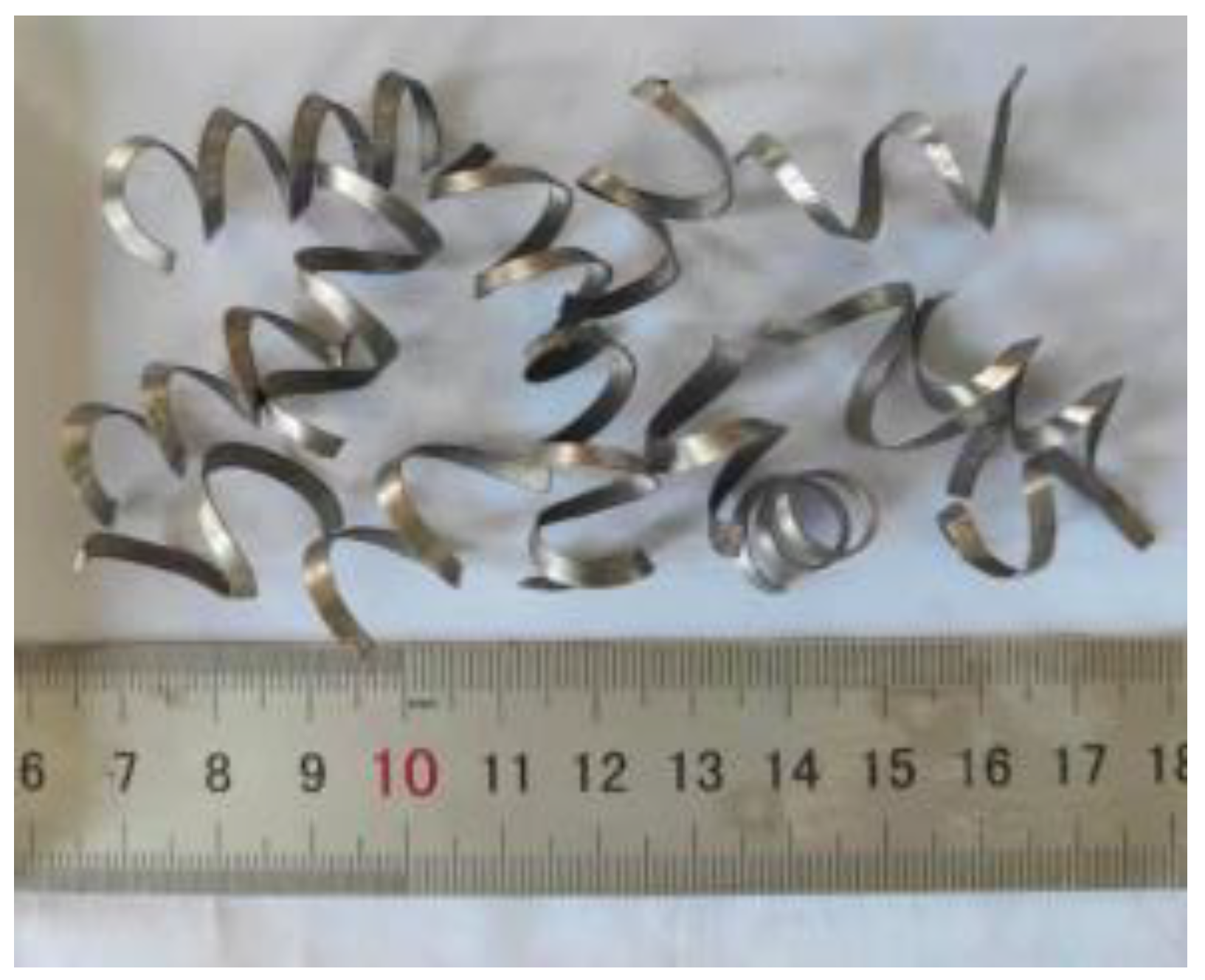
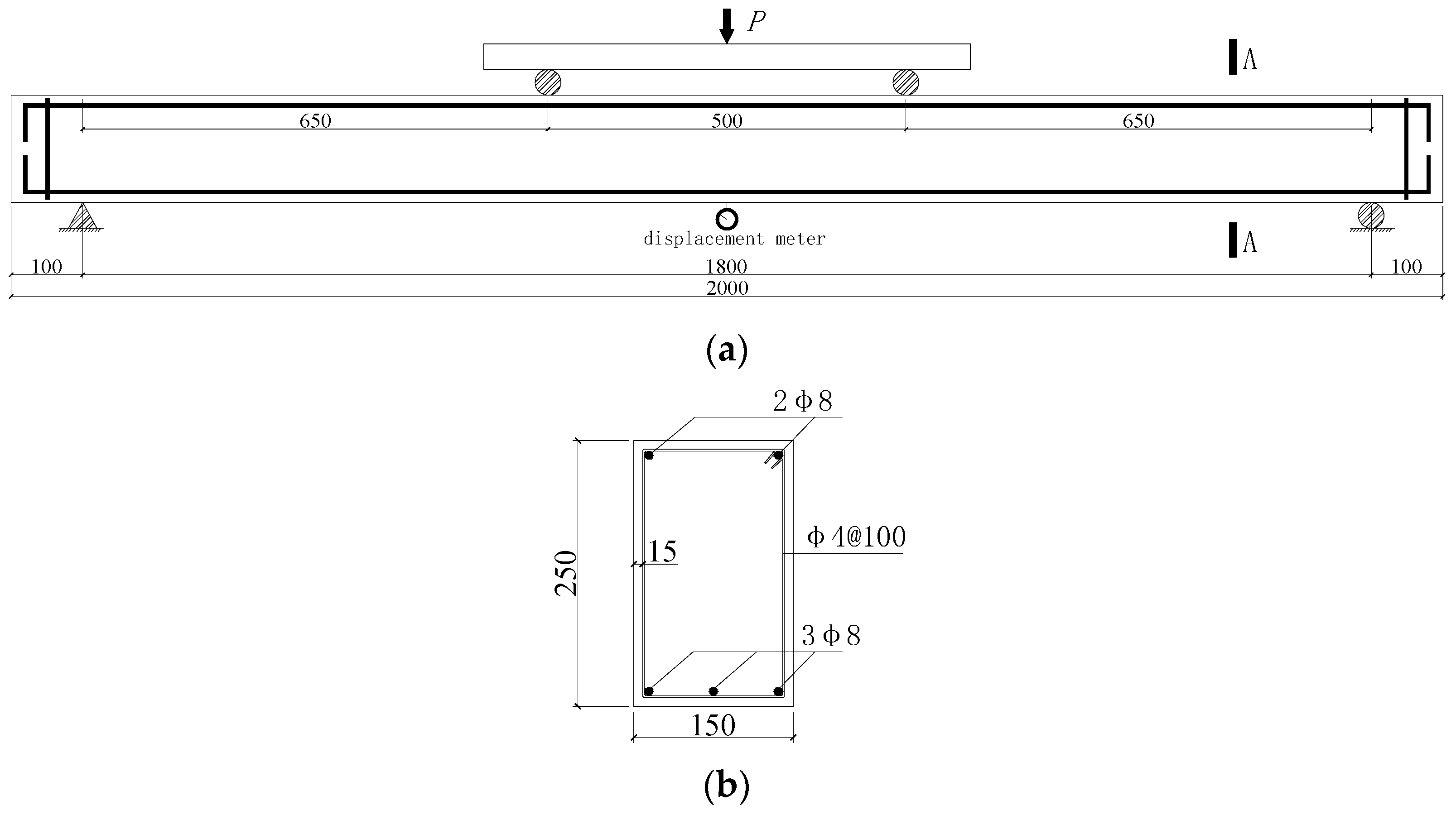


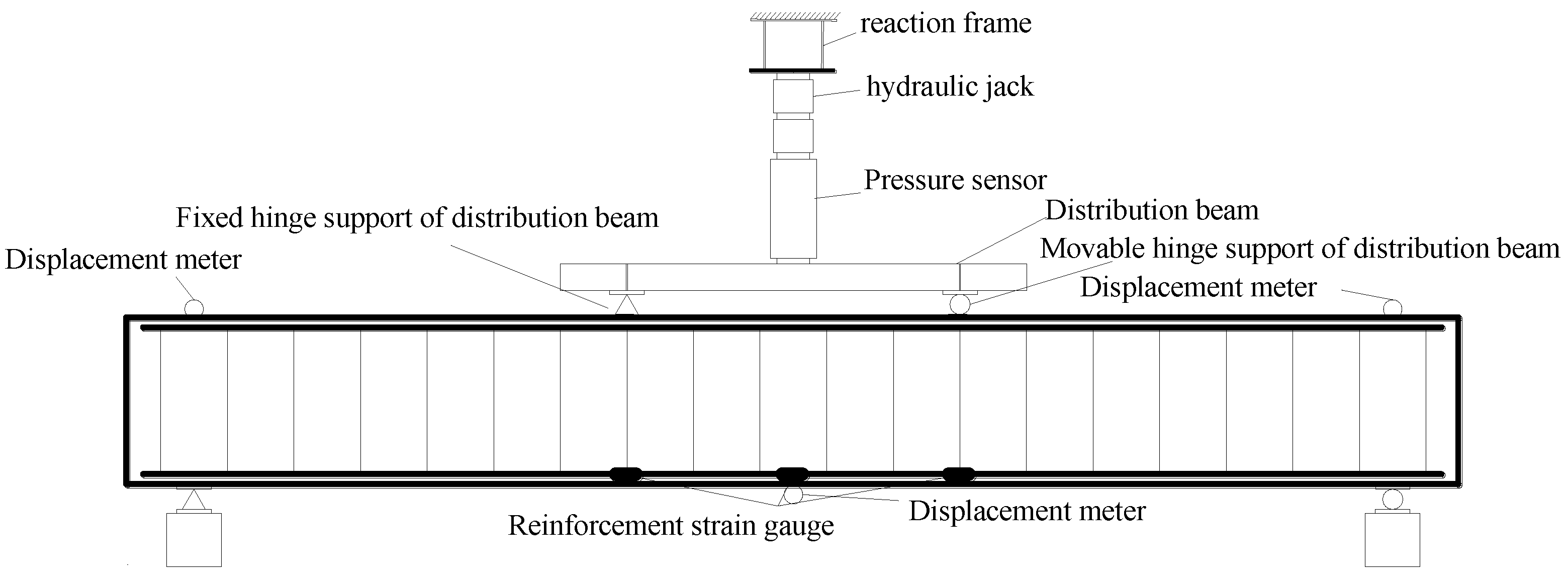

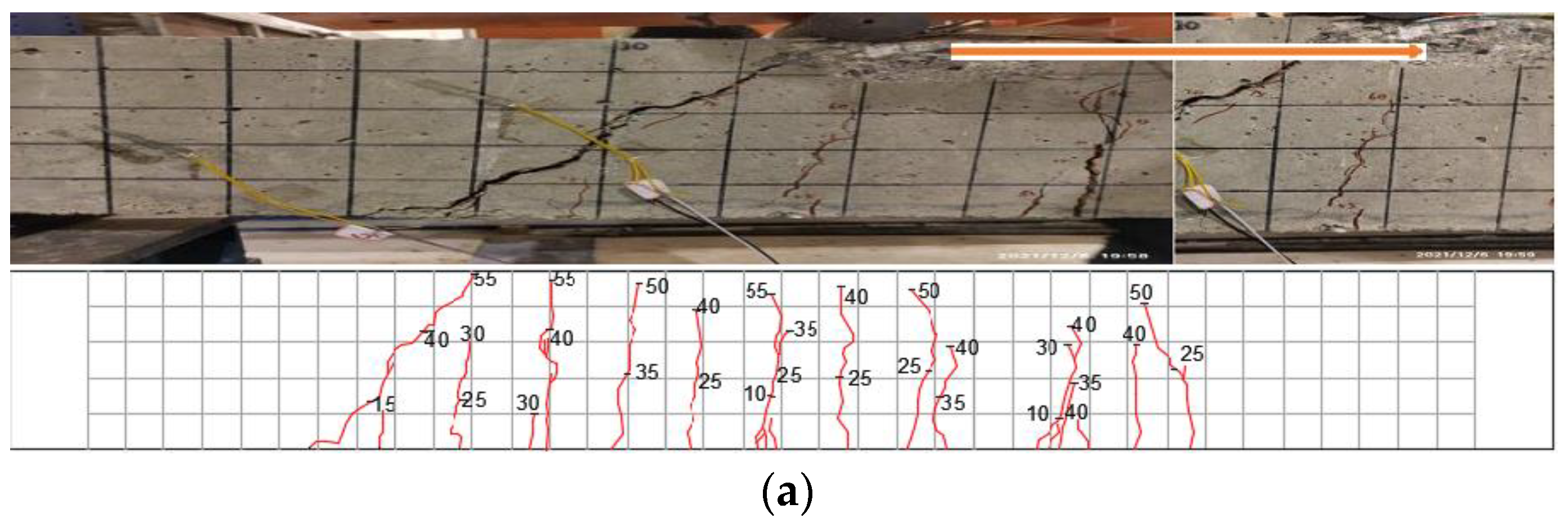


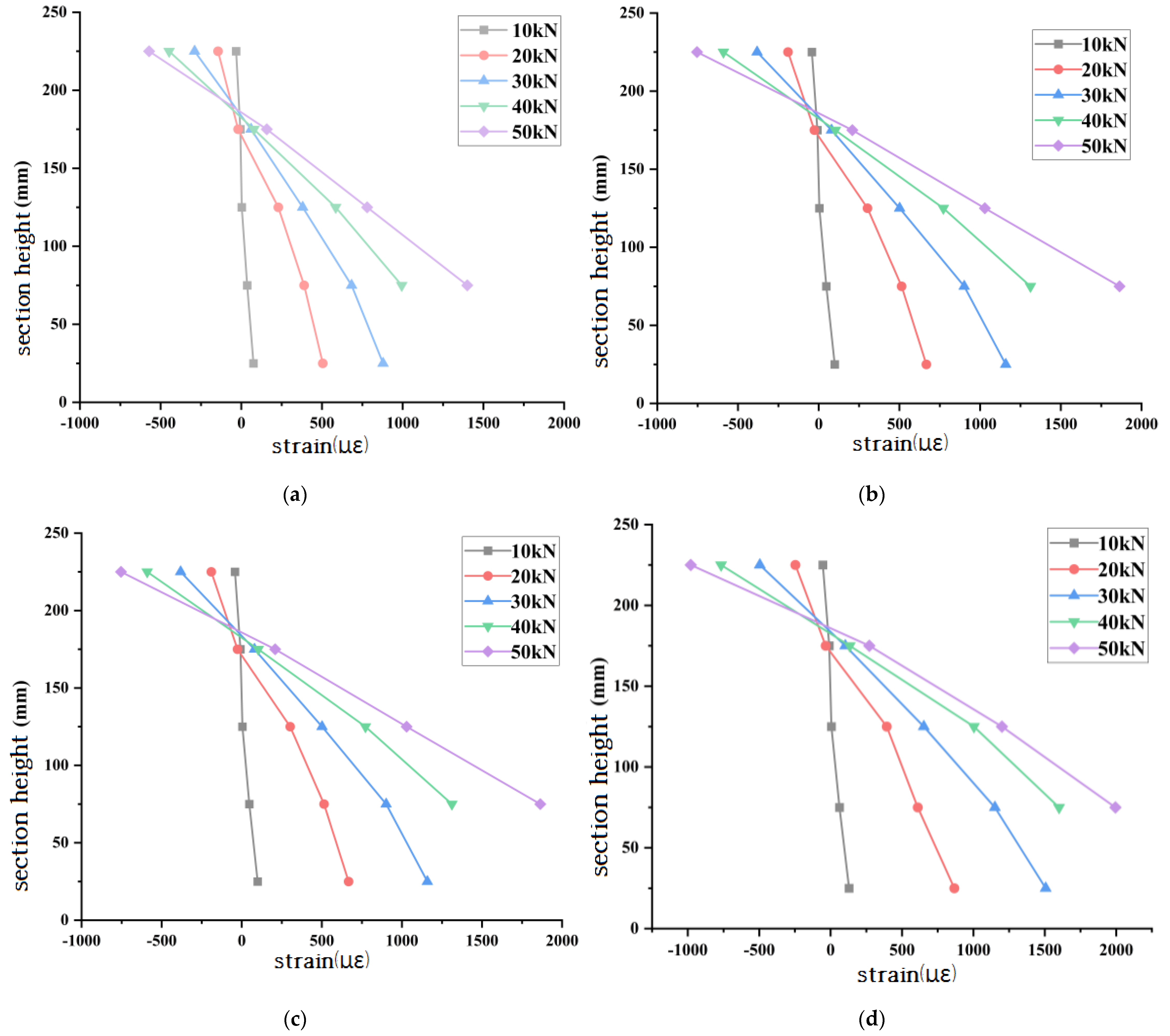
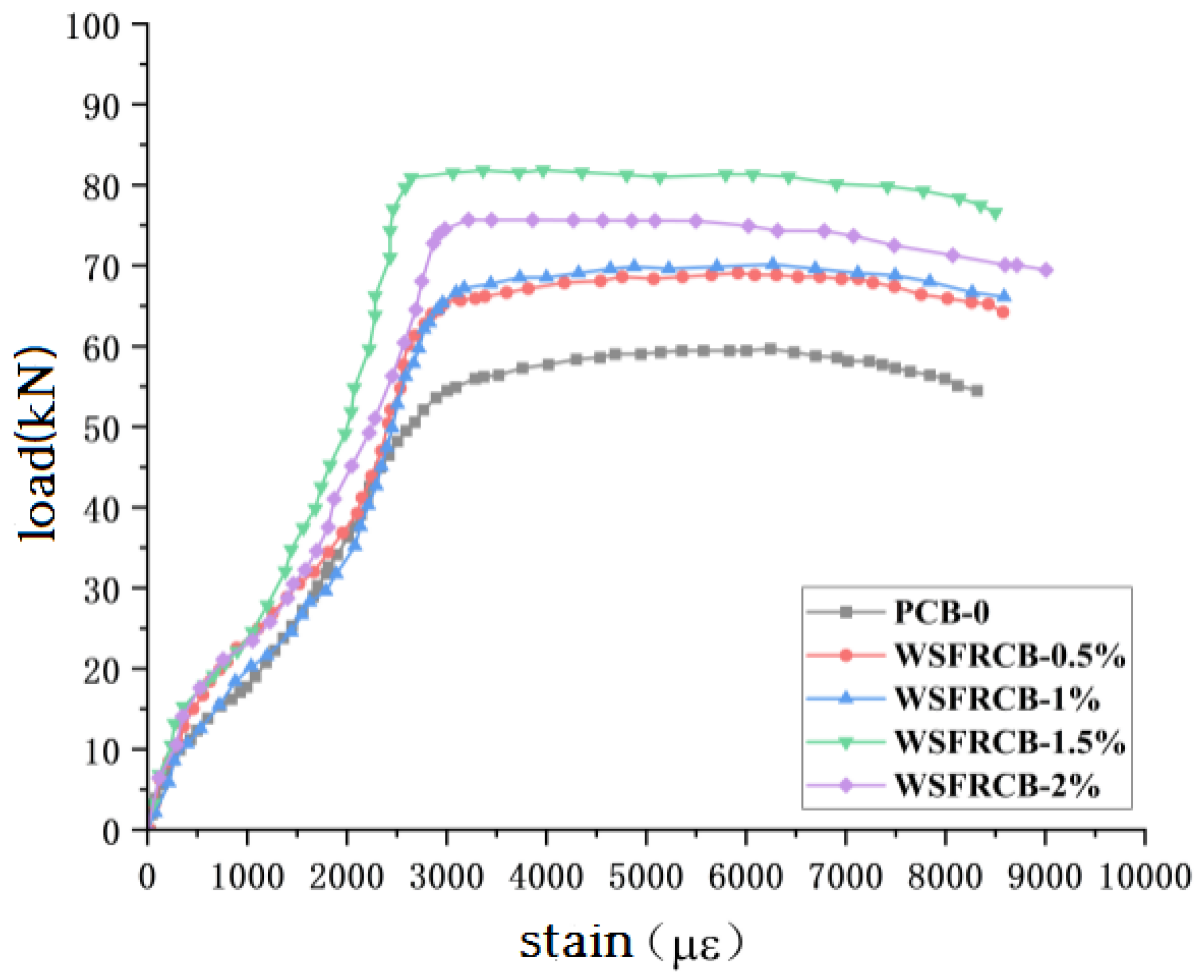

| Kind | Particle Size | Mud Content | Apparent Density | Loose Packing Density |
|---|---|---|---|---|
| Gravel 1 | 5–10 mm | 0.5% | 2680 kg/m3 | 1385 kg/m3 |
| Gravel 2 | 10–20 mm | 0.7% | 2690 kg/m3 | 1405 kg/m3 |
| Amount of Material | Sand | Gravel | Cement | Water | High-Performance Water-Reducing Agent |
|---|---|---|---|---|---|
| kg/m3 | 644 | 1251 | 380 | 175 | 1.14 |
| Number | Volume Content of Steel Fiber /% | Dosing of Steel Fiber /kg |
|---|---|---|
| NCB | 0 | 0 |
| RSFCB—0.5% | 0.5 | 39 |
| RSFCB—1.0% | 1 | 78 |
| RSFCB—1.5% | 1.5 | 117 |
| RSFCB—2.0% | 2 | 157 |
| Number | Fcr (kN) | Mcr (kN·m) | Fu (kN) | Mu (kN·m) |
|---|---|---|---|---|
| NCB | 5 | 1.56 | 55 | 17.19 |
| RSFCB—0.5% | 6 | 1.88 | 60 | 18.75 |
| RSFCB—1.0% | 8 | 2.5 | 65 | 20.31 |
| RSFCB—1.5% | 10 | 3.13 | 82 | 25.63 |
| RSFCB—2.0% | 8 | 2.5 | 78 | 24.38 |
Disclaimer/Publisher’s Note: The statements, opinions and data contained in all publications are solely those of the individual author(s) and contributor(s) and not of MDPI and/or the editor(s). MDPI and/or the editor(s) disclaim responsibility for any injury to people or property resulting from any ideas, methods, instructions or products referred to in the content. |
© 2023 by the authors. Licensee MDPI, Basel, Switzerland. This article is an open access article distributed under the terms and conditions of the Creative Commons Attribution (CC BY) license (https://creativecommons.org/licenses/by/4.0/).
Share and Cite
Yan, J.; Gao, Y.; Fan, T.; Xu, Q.; Yuan, W.; Zhao, X. Experimental Study on Flexural Performance of Recycled Steel Fiber Concrete Beams. Buildings 2023, 13, 3046. https://doi.org/10.3390/buildings13123046
Yan J, Gao Y, Fan T, Xu Q, Yuan W, Zhao X. Experimental Study on Flexural Performance of Recycled Steel Fiber Concrete Beams. Buildings. 2023; 13(12):3046. https://doi.org/10.3390/buildings13123046
Chicago/Turabian StyleYan, Jinqiu, Yongtao Gao, Tao Fan, Qiang Xu, Weiguang Yuan, and Xiao Zhao. 2023. "Experimental Study on Flexural Performance of Recycled Steel Fiber Concrete Beams" Buildings 13, no. 12: 3046. https://doi.org/10.3390/buildings13123046





